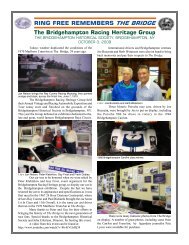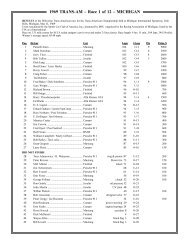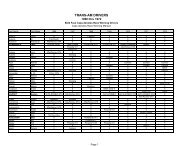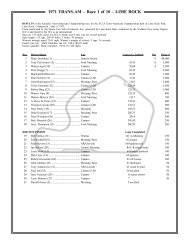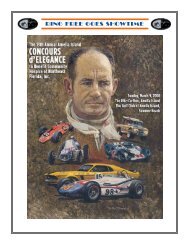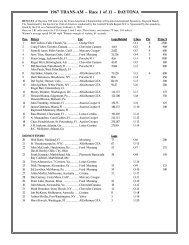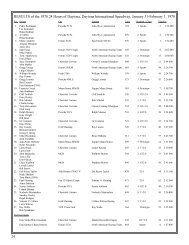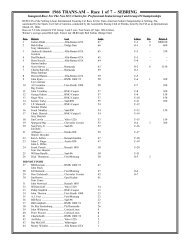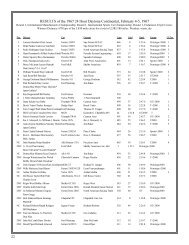Daytona Highlights 1970 - 1966 Shelby Notchback Mustang
Daytona Highlights 1970 - 1966 Shelby Notchback Mustang
Daytona Highlights 1970 - 1966 Shelby Notchback Mustang
You also want an ePaper? Increase the reach of your titles
YUMPU automatically turns print PDFs into web optimized ePapers that Google loves.
RAY CUOMO RACINGENTERPRISES, Ltd.<strong>1970</strong> 24 Hours of <strong>Daytona</strong>Unlike many of her sister cars, <strong>1966</strong> <strong>Shelby</strong> <strong>Notchback</strong>Number 6 did not see competition again until John Gimbeltraded Ray Cuomo, now President of Ray Cuomo RacingEnterprises, his street GT-350 for Number 6, a car trailerand a 1963 Blue Oldsmobile Station Wagon affectionatelycalled “The Blue Whale”. John used #6 to obtain his Regional,National and FIA licenses.In January of <strong>1970</strong>, Ray Cuomo Racing Enterprisesentered the car for John in the <strong>1970</strong> 24 Hours of <strong>Daytona</strong>.George (Corky) Lisberg would be Johns co-driver. Raywould co-drive a GT40 (GT/103) in the race with car ownerWilliam Wonder.John and Ray asked Jan and myself to be part of John’spit crew. This was to be our first involvment with <strong>1966</strong> <strong>Shelby</strong><strong>Notchback</strong> Number 6.Practice began with George loosing the left rear axle andwheel just before the start/finish line, right in front of theGrandstand and pits! Tack welds securing the bearing retainerto the axle had broken. Fortunately, the errant wheel and axledid not hit any of the other cars, although, one of the Matrasjust missed it. It ended up on the grass in front of the pits. Iwent out to retrieve the wheel and axle, foolishly picking itup by the splined end of the axle. I wound up with 28 splinesbranded into the palm of my hand.On the way down to Florida with Jan, “Uncle” Ray and“Uncle” Gene, Rays brother, we lost the fan belt on the towcar. Parked on the side of the road waiting for the engine tocool down, Fire Engines arrived. Someone had seen the“smoke” (steam) and called the Fire Department.New rule changes greeted us when we got to the track.George, who had left NY before us with the race car, wasbusy installing a now mandatory FULL roll cage. Weightalso had to be added. We picked up 2 hugh elevator weights,along with a 1” thick piece of steel about 14” square, to bringthe car up to the new weight requirements.After succeeding in our mission to pick-up some weights,we deceided to stop for lunch before returning to the track.Upon hearing a door bell ring, we noticed the bartender opena sliding window behind the bar. On the other side was acustomer, sitting in his car, he ordered a drink and proceededto drive away. Guess this was the beginning of today’s Drive-Thru’s!Once back at the track, one elevator weight was boltedup on the shelf forward of the gas tank in the trunk. Theother elevator weight was bolted to the floor next to the driverin the passenger seat area. The slab was bolted to the floorbehind the driver.The Mark Donohue, Peter Revson Sunoco Trans-Am Javelin.The <strong>1970</strong> 24 Hour was the final test for the new RogerPenske AMC Sunoco Trans-Am Javelin. The car qualified19th with a 2:08.4. Lasting around 7 hours, completing 205laps, Roger Penske was asked if he was dissappointed, hemade the point that “7 hours was equal to 3 Trans-Am races!”A 2:27.2, for a lap speed of 100.614 mph, put us 46th onthe grid. In 1967, Ray Cuomo and Paul Richards qualifiedthe car 39th with a 2:24.7 for a lap speed of 101.734 mph.Number 6 Takes the Green Flag
RAY CUOMO RACINGENTERPRISES, Ltd.<strong>1970</strong> 24 Hours of <strong>Daytona</strong>George in the first turn heading towards the signal pits.In <strong>1970</strong> there were “Signal Pits” just after the first turnheading towards the kinks. This is where you used your “pitboard” to signal your driver. It was a cold night. Everyonewas wearing winter jackets and most teams had heaters.Number 14 (#6) takes the Checkered Flag after 24 hours.The only unscheduled stop during the 24 hours took placearound 9:00 in the morning for points and plugs.View of <strong>Notchback</strong> Number 6 from the signal pits at dusk.We all took turns in the signal pits. It was a great view of thecars coming out of the first turn going into the infield portionof the course. It was a cold and windy night and in the earlymorning hours the signal pits, just a wood frame shelter withplastic sheeting for a back wall, blew down!John pulls into the pits after the cool-off lap. Ray Cuomo inthe blue Goodyear jacket and the right front fender of theGT40 can be seen on the right side of the photo.When the checkered flag fell, John and George completed520 laps, finishing 2nd in Class and 16th Overall. Ray Cuomoand Bill Wonder finished 5th in class and 8th Overall in theGT40, completing 579 laps.The William Wonder / Ray Cuomo GT40 (GT/106)Our pit was just in front of Bill Wonders GT40 stall soRay was able to keep an eye on his entry.<strong>Daytona</strong> <strong>1970</strong> was the first time the car wore Number14, not to be confused with its <strong>Shelby</strong> <strong>Notchback</strong> ProductionNumber 6 as referred to elsewhere. Jan Nelson and I boughtthe car from John after this race. Due to the cars success at<strong>Daytona</strong>, Jan and I requested and was assigned Number 14,by the SCCA, for the Trans-Am series.l to r: George (Corky)Lisberg, John Gimbel andRay Cuomo.



